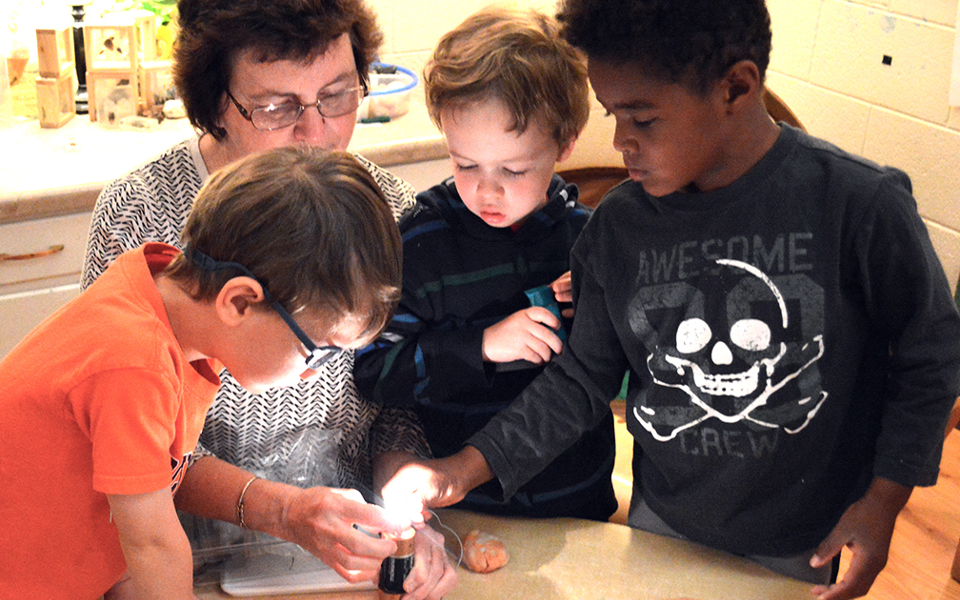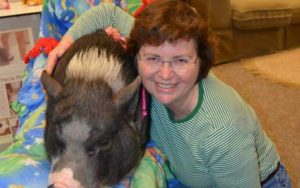When you walk into any of the three classrooms in Virginia Tech’s Child Development Center for Learning and Research, you’re met with warm lighting and open spaces.
“We want our center to feel like home,” said Alexa Gardner, curriculum coordinator of the center, which is housed in Wallace Hall. “We want the children to feel it’s a wonderful place to be.”
Gardner credits classroom spaces, teacher interactions, and the emergent curriculum as key components of the center’s recent Level 5 rating from Virginia Quality, the state’s voluntary quality rating and improvement system. At the time of its rating earlier this year, the center was one of only five child care centers statewide to achieve the highest level of quality.
“We try to be a model program here,” said center director Karen Gallagher, who earned a bachelor’s in human development in 1995 and a master’s in teaching and learning in 2004, both from Virginia Tech. “We have so many resources available to us, such as graduate and undergraduate students and a campus environment that affords us a duck pond, horticulture gardens, theaters, and other enrichment opportunities.”
The Virginia Quality evaluation process was recently modified from past years, which used a star-based system. The previous time the Child Development Center for Learning and Research was rated, in 2012, it received four out of five stars.
“The last time our center was assessed, we were only about seven points away from a five-star rating,” Gallagher said.
Now the system focuses on three criteria: regulating authority, quality rating standards, and professional development. The quality rating standards, in turn, have five levels based on the quality of basic health and safety, education and qualifications, curriculum and assessment, and environment and interactions.
The Virginia Tech center is accredited by the National Association for Education of Young Children, whose high standards automatically ensure a minimum rating of a Level 3. An onsite rater further evaluated the center’s environment and quality of interactions, which were rated at a Level 5.
“Centers can achieve quality in many ways,” Gardner said. “Virginia Quality focuses on the classroom environment and teacher interactions. And this program sends a rater to verify teachers’ qualifications and to observe what they’re actually doing in the classroom.”
Gardner, who also received both her degrees — a bachelor’s in human development in 2005 and a master’s in teaching and education in 2006 — from Virginia Tech, has served as the center’s curriculum coordinator since 2011. Before that, she was a classroom teacher.
Licensing requires staff to complete a certain number of professional development hours. Gardner says the center tries to exceed the requirement.
“Our teachers play a huge role in helping the children learn,” Gardner said. “They frame their curriculum around the children’s needs and interests.”
The center is also able to retain teachers far longer than is standard in the child care industry.
“We have several veteran teachers who excel at mentoring new staff coming in,” Gardner said.
Both Gardner and Gallagher encourage teachers to focus the curriculum on the children’s interests. They pride themselves on running a model preschool program.
“We really view the children here as capable and competent,” Gallagher said. “We allow them to pursue their interests. Children can see, reach, and use a tremendous amount of materials. And we don’t dictate to them how those materials have to be explored. I think the children appreciate that because it allows them to grow.”
Cindy Smith, an associate professor of human development who runs the Children’s Emotions Lab at Virginia Tech, said, “The teachers are wonderful in how they provide such a nurturing environment and support the children’s learning through play.”
“We want them to learn how to think and problem-solve,” Gardner said. For example, when children in the older classroom expressed an interest in experimentation with cause and effect, teachers extended this scientific inquiry by providing D-cell batteries, coated wire with stripped ends, and flashlight bulbs for the children to experiment with circuit electricity.
“From the moment I walk into the center’s classrooms, I can tell they differ from many early-childhood settings,” said Anisa Zvonkovic, head of the Department of Human Development and Family Science. “The children are actively involved in what they’re doing, and they’re keenly interested in the materials they’re using.”
Gardner emphasizes the center’s role in the community. Teachers from the surrounding New River Valley area often visit the center. Staff members also mentor other child care centers in the region.
“One of our main goals is to ensure that quality care exists for all of the children in our area,” said Gardner.
Housed in the Department of Human Development and Family Science in the College of Liberal Arts and Human Sciences, the center dates back to the 1940s. It used to be a lab school, but now operates as a full-time child care center. Over the years, the center has engaged Virginia Tech students through field study and service-learning opportunities.
“We’re provided with so many resources through our department and the university,” Gallagher said. “That support is a big part of why we’re able to do what we do.”
Gardner said the children love coming into the center each day.
“They have many choices, and a great deal of independence and flexibility,” Gardner said. “The teachers are passionate about what they do, and the children can feel that.”
Written by Olivia Coleman




